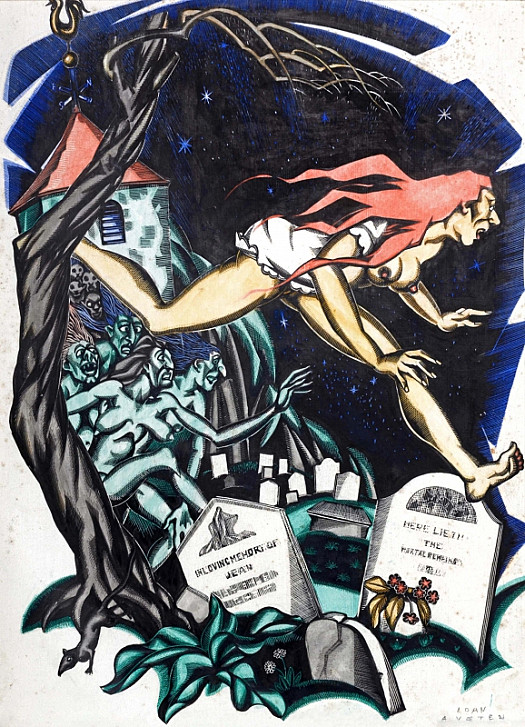John Archibald Austen, RBA (1886-1948)
Early influenced by the work of Aubrey Beardsley, John Austen developed into an illustrator of wit and elegance by the mid 1920s, producing unusually decorative images that are associated with Art Deco. Both craftsman and auto-didact, he mastered a range of media, including etching and wood-engraving, and absorbed a variety of styles and motifs.
John Austen was born at 19 George Street, Buckland, near Dover, Kent, on 5 January 1886. He was the second child of the carpenter, Walter Austen, and his wife, Priscilla (née Hooker), the daughter of an agricultural labourer. On leaving school, he followed his father, and trained as a carpenter. However, in 1906, he moved to London, determined to become an artist, and initially took Aubrey Beardsley as his model.
His studies were supplemented by life classes, and relieved by amateur dramatics. In the words of the novelist, Dorothy Richardson, he became a ‘long-haired studio exquisite’, entering a bohemian circle, which also contained Richardson’s husband, Alan Odle, and Austin Osman Spare. Exhibiting with the Royal Society of British Artists, he became an associate in 1919 (and a full member in 1921).
In 1919, Austen married Ruby ‘Tommy’ Thomson, the daughter of a police pensioner, who would become his chief model. They settled in St John’s Wood, and by 1926 were living at 16 Circus Road. He became a staff member of the Penny Illustrated Paper, and a year or more later illustrated his first book, R H Keen’s The Little Ape (1921). Subsequent books, including an edition of Hamlet (1922), contributions to The Golden Hind (co-edited by Spare) and advertising commissions, all demonstrated a gradual stylistic independence, veering towards Art Deco decoration. With the help of the art critic, Haldane MacFall, Austen held a joint exhibition with Odle, Spare and Harry Clarke at the St George’s Gallery in 1925; there he showed his illustrative artwork for the first time, including several drawings from the recently published edition of Longus’ Daphnis & Chloe. The fame of this group was helped by the publication of Dorothy Richardson’s John Austen and the Inseparables (1930).
At the close of the 1920s, and following an illness, Austen returned to Kent with his wife. Throwing off his aesthetic appearance, he shared his time between his artistic work and country pursuits. Living first in New Romney (circa 1928-36), he and his wife later moved to a converted oast house in Petham and then at Heart’s Delight Farm, Wingham. He produced illustrations for – especially – American publishers of limited editions, and turned his hand to writing, producing most notably a study of Don Juan (1939).
He also taught at the Canterbury and Thanet Schools of Art, and shared his expertise with a wider audience through the manual, ABC of Pen and Ink Rendering (1937). Shortly before the outbreak of the Second World War, he and his wife moved into Rose Cottage, Burmarsh Road, West Hythe. When his health began to deteriorate, he lived in straightened circumstances, though was supported by a Civil List pension. Dying at home on 27 October 1948, he was survived by his wife.


